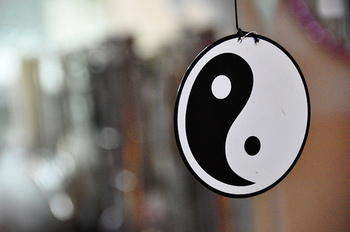
You have probably seen this symbol before, perhaps as earrings or as a sticker on the back of a VW bus. But do you understand what it means? In Chinese, it’s called the “taiji,” and in English, we know it as the yin/yang symbol. It is also called the law of the unity of opposites. Yin and yang describe the two essential forces inherent in all of nature. The white half with the black dot represents the yang, or masculine energy, while the black half with the white dot represents the yin, or female energy. Understanding this model can give us a deeper understanding of nature, ourselves and our health. The original meaning of yang is “the sunny side of the mountain,” while the original meaning of yin is “the shady side of the mountain.”
| Yang Qualities | Yin Qualities |
| Masculine | Feminine |
| Hot/Warm | Cold/Cool |
| Dry | Moist |
| Day | Night |
| Summer | Winter |
| Space | Earth |
| Activity | Rest |
| Function | Structure |
| Expansive | Contracting |
| Outward | Inward |
| Back of body | Front of body |
| Hollow organs | Solid organs |
Characteristics of Yin & Yang
-
Opposition
They struggle with and control each other. One example of this in nature is high and low pressure systems in meteorology. -
Interdependence
They define each other. Neither can exist without the other. There would be no male without female. Without day, there would be no night. -
Mutual Consumption
Yang (activity) consumes yin (substance). For example, we burn fat and lose sweat when we exercise and it takes energy (yang) to create and store fat (yin). -
Inter-transformation
They become each other. The dot in each half of the symbol represents the “seed” of the other. Yang contains the seed of yin and vice versa. Night gradually gives way to day, which gradually gives way to night. If we push too hard in an active (yang) way, a restive (yin) state will follow (exhaustion, death).
Men, Women & Aging
Men are more yang than yin. In youth, they are generally stronger and faster. Their physiology tends to be warmer. However, because of the inter-transforming nature of yin and yang, as men age, yang declines and men tend to feel cold (yin) more easily. They tend to fatigue more easily and need more rest (yin). Most men feel better with herbs and foods that supplement yang energy.
Foods and Herbs that Supplement Yang:
Grains: quinoa, buckwheat
Vegetables: radishes, parsnips, mustard greens, sweet potatoes, kale
Fruits: cherries, dates
Nuts: walnuts, pine nuts, sunflower seeds
Seafood: shrimp
Meats: lamb, lamb kidney, mutton
Herbs: ginger, cinnamon, fennel, star anise
Women are more yin than yang. In youth, their bodies are able to produce children. Because they menstruate, their bodies produce more yin fluids (blood, vaginal lubrication, etc.). As women age, their cooling and moistening (yin) energies naturally decrease. They feel warmer and experience hot flashes (yang). They may experience dryness (yang). Many women feel better with herbs and foods that nourish yin and fluids.
Foods and Herbs that Nourish Yin:
Grains: millet, barley, amaranth
Vegetables: beets, string beans, kidney beans, mung beans
Fruits: persimmons, grapes, blackberries, raspberries, bananas, watermelon
Dairy: goat’s milk, yogurt, eggs
Seafood: clams, abalone, oysters
Meats: duck, organic beef, organic pork
Herbs: chlorella, spirulina, goji berries (lycium), American ginseng
Please keep in mind that these are gender-based tendencies of what happens to men and women as they age. However, other factors such as lifestyle, diet, and inherited tendencies may create a very different situation. If you are “hot-blooded,” it is better to avoid foods and herbs that nourish yang. If you are cold, overweight and fatigued, it is better to avoid yin-nourishing foods and herbs. To get an accurate, personalized assessment of your yin and yang, visit a licensed acupuncturist.
Want more expert tips for leading a healthier life? Visit Tips for Healthy Living.


